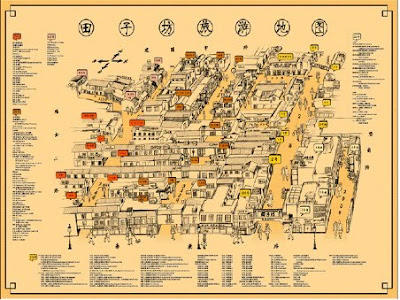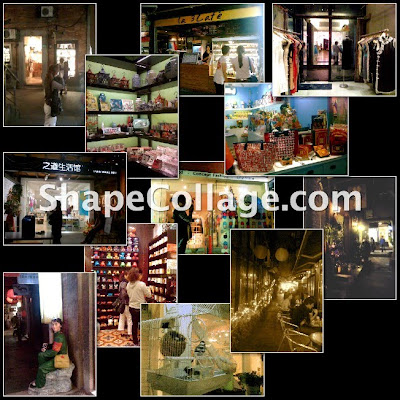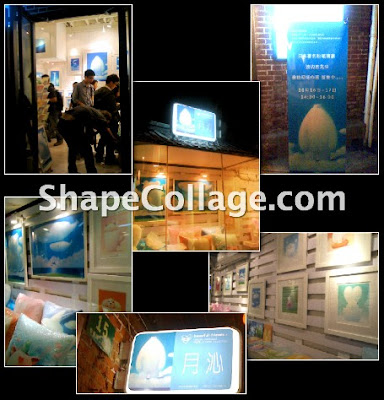
We stayed at the 3-year-old boutique hotel, JIA Shanghai. JIA is actually the phonetic spelling of the Chinese word “Top of Form家”, meaning home. A really apt name, as we enjoyed immensely our short 3-night stay there and were made to feel at home, basking in the creature comforts provided by the hotel.
While JIA Shanghai may aim to be a second home for their guests, do not mistake this to mean drab, homey surroundings. Au contraire, this stylish “home” is anything but dull, with interesting interiors and playful décor that mix and match European designer fixtures with Chinese objects and furniture. This playful contrast is further emphasized by the juxtaposition of a gently restored 1920s art deco building façade, with hip, modern interiors, once we enter through its unassuming entrance, indicated simply, with an almost inconspicuous JIA signage.
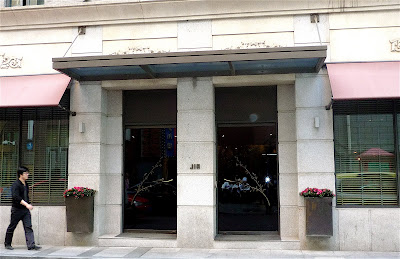
The whimsy factor greets us at the lobby with arty installations of oversized leather teddy bears and birdcages hovering over the centerpiece Cascade installation by sought-after Asian designer Andre Fu.
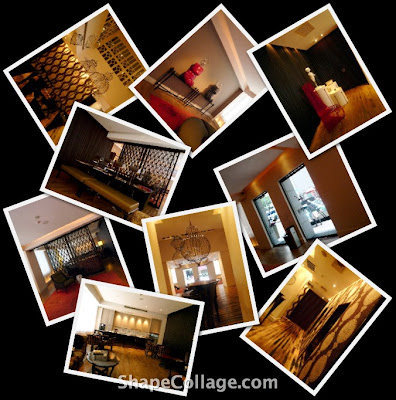
While we waited to check in, the friendly staff whisked us to the adjoining lobby lounge. Here we continue to take in an eyeful of the surrounding ornate design-ladden fixtures and furnishings, while grabbing a mouthful of a small selection of cakes and cookies that’s served during the complimentary afternoon tea hours. From the self-service bar counter, guests have access to complimentary soft beverages (bottled water, milk, juices, soda, teas and coffee) round the clock and wine in the evening. Before we head out to explore the city, we usually find ourselves lounging comfortably on the silken sofas, with a glass of juice at hand, while we await our cabs to arrive. And if we anticipate a long day ahead, the hotel made it convenient for us to take-away our coffee and pack some cookies on our journey, by providing take-away paper cups and nifty little JIA-branded brown paper pocket envelopes.
We stayed at the 42 sq m studio plus room. This tastefully furnished studio comes replete with a comfy king-size bed, well-equipped kitchenette (induction stove, microwave, appliances, cookware and tableware for 2), a long desktop space, an oversized sofa, the requisite flat screen TV and a marble/Bisazza-gilded bathroom with rain shower and a generous-sized bathtub. There’s also the super-sized fluffy towels, comfy terry cloth bedroom slippers and luxury linen.

A dose of tongue-in-cheek humor is injected into the room, with JIA branding their toiletries with alternative monikers (shampoo becomes “head start”, hair conditioner is “head smoothie”, body wash “freshen up” and this one will made us smiled on that sleepy morning - body lotion as “smooth operator”. They were all fragranced with customized Jasmine & Ginseng scent, which smells terrific btw. I usually abhor the heady scent of Jasmine, but somehow this Jasmine-Ginseng blend works and gives off such a nice balanced fragrance that I actually don’t mind masking myself in it from head to toe. There are the doorknob hangers that read “seriously need sleep” (instead of the usual “do not disturb” signs) and “seriously messed up” (instead of the usual “please make up room”); and a quirk of localized nostalgia is injected with the provision of the locally manufactured, classic-brand, White Rabbit Sweets to chew on, while you choose from the stocked in-room Monopoly China board game, Chinese chess or browse Chairman Mao’s Little Red Book (“Quotations from Chairman Mao Tse Tung”)!
In the bedroom, along the long desk, we found this nifty plug-in panel concealed behind a wall flap. On the panel are multi-plug sockets (No need to pack the adaptors. Yay!) and various ports for plugging in iPhones, MP3s, laptops for charging as well as seamlessly connect to the built-in ceiling speakers installed in both the bedroom and toilet. If you use a regular laptop (i.e. non-Macs. I was using a Mac unfortunately. Hopefully, they’ll provide for Mac in future.), you can even use the provided cables to connect it to the large-screen TV. With the complimentary wifi available all throughout the hotel, you can conveniently access the internet on your iPhone, iPad or laptop, whether you’re at the bedroom, restaurant, lobby lounge etc.
And the most welcomed JIA perk that totally calls to mind the comfort of home? Waking up to a fortifying, hot cooked breakfast, mmm… (heck, it’s even better than “home”, cuz back home, my breakfast choices are hardly as delicious!)

Breakfast is served on the second-floor, at the sole restaurant, Issimo – an Italian restaurant that serves supposedly good, authentic Italian food (was too busy eating the streets of Shanghai, so did not get to try) for lunch and dinner, while in the morning, it doubles up as a breakfast room for guests. The breakfast is “complimentary” for all guests, which means it is probably worked into the daily room rate. But it’s pretty good variety and quality, so we didn’t begrudge it as one of those token inclusive “free” breakfasts that we wished that the hotel would do away with and rather exchange it for a cheaper room rate instead.
And it’s not a self-service, eat off the buffet food warmers type of breakfast either. This is, above all, a designer hotel. So to keep things classy, guests receive table service and get to order a 2-course breakfast (with 3 options for the cold starters and 6 options for the warm mains – recommend the scrumptious Eggs Benedict, but skip the Shanghainese wonton noodle soup. It’s actually Italian pasta in pseudo-Chinese broth. Issimo is Italian after all.), with choice of juices, coffee/tea/hot chocolate and selection of breads/Danish. Sigh … we sorely missed the JIA breakfast experience after we got home.
We didn’t manage to check them out, but JIA also has a Technogym and an Office and Conference room in Business Centre.
JIA Shanghai is JIA group’s second hotel venture after the hyped Philip Starck hotel - JIA Hong Kong. Both boutique hotels are multi-award winning hotels, and are often featured in travel magazines’ “hot list”, “it list”, and are pretty much firmly entrenched in the “hip hotels” sphere. JIA Shanghai also just won Trip Advisor’s traveller choice award for 2010. So they’ve basically won over both the critic and the consumer.
But accolades aside, we immensely enjoyed our stay at JIA Shanghai for all the reasons I’ve rambled on above, and also because of its size and location, and the friendly service from the bilingual staff (most can speak passable English, though I did use Mandarin to communicate with them most of the time). Being a boutique hotel, JIA only has 55 rooms spread over 7 floors. So it doesn’t feel overly busy, as compared with large chain hotels, and you need not jostle with swarming tourist crowds when you lounge at the lobby or have your breakfast. The hotel is also literally a stone’s throw away (just a few paces across) from the nearest subway station of Nanjing Rd (W) station. But to be honest, since cab fare is relatively cheap we usually just hail for cabs and when it gets hard to call for one, since we were there during the crowded Shanghai Expo weekend, we walked. Being located at the intersection of Taixing road and the main thoroughfare of West Nanjing Road, JIA is relatively accessible by foot to the interesting neighbourhoods of Changle Road (Cheongsam shops) and Fumin Road, the French Concession (Huaihai Zhong Road, Fuxing Zhong Road, Maoming Nan Road, Sinan Road), and the charming Tian Zi Fang along Tai Kang Road (more on this in a later entry). But of course, we are the same folks that find a 1-hour walk from JIA all the way to The Bund rather manageable. The staff baulked at us when we asked them if it was possible to walk to The Bund. Nevertheless we found ourselves making our way on foot to The Bund, after we waited 1-hour in vain for a cab. The weather was cool and pleasant and we enjoyed taking in the sights along Nanjing West Road, so it was a rather enjoyable stroll.
The rack rate for the studio plus room we stayed in is usually RMB 2000++, but we snagged a slight discount with their promotional deal on JIA’s website (http://www.jiashanghai.com) for RMB1700++ per night, so do check out their website and possibly the usual hotel bookings portals (three that I’ve previously used and had no problems thus far, are booking.com, hotels.com and asiarooms.com) for price comparisons?
On a side note, I’ll like to highlight 3 great snacks found near JIA (yes, I’ve ranked them in order of merit, based on personal preferences)
- Yang’s Fried Dumpling, 小杨生煎 (xiao yang sheng jian)
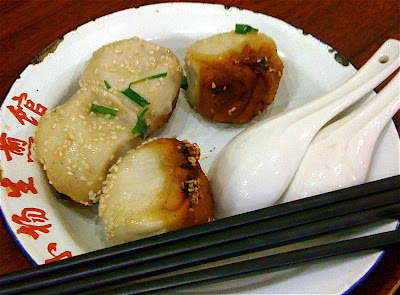
This popular street snack is located on the 2nd floor of the 湟普汇 mall, which stands over the entrance of the Nanjing West subway station, just a few paces across, from the right side entrance of JIA. The mall as pictured below, right on Wujiang Road, 吴江路 .

Once you reach the second floor, you should be able to locate Yang’s just right by the escalator, with its impossible-to-miss queues spilling out its shopfront. This place is a hit with both locals and foreign travellers.
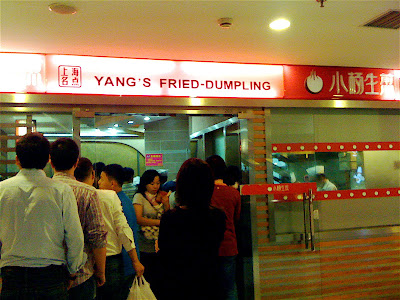
Fried dumplings 生煎包 (sheng jian bao) are a local specialty and Yang’s, which was set up in 1994, and has now expanded to 19 outlets, is an institution in Shanghai, having been awarded the Shanghai Famous Snack 上海名点 (shang hai ming dian) accolade in 2004.
For the uninitiated, it’s easy to confuse fried dumplings with soup dumplings (小笼包 xiao long bao or 汤包,tang bao) another famous Shanghainese snack, as both are forms of pork dumplings. Xiao Long Bao or soup dumplings are smaller, generally made of thin, smooth dumpling skin and are steamed, while Sheng Jian Bao, fried dumplings, are made of fluffy leavened dough and are pan-fried. Both are enjoyed in a similar style though, best accompanied with a sweet vinegar dip (and sometimes with grated ginger for soup dumplings), that lifts the succulent but often greasy pork. And because both dumplings contain a soupcon of hot broth encased in them, it's recommended to eat them the same way – pick up the buns by its sides, chew off a little opening from its side to slowly sip the piping hot juice (or sometimes, tilt the bun and drain the broth into your soup spoon to slowly enjoy) and then dip the drained bun in vinegar and sink your teeth into the pork and dumpling skin.
We absolutely love Yang’s fried dumplings. It’s perfection in a bun really. From the fragrant sprinkling of sesame seeds and scallions atop the bun to its fluffy yet slightly crispy (thank to its pan-fried bottom) casing to its flavorful broth to the succulent pork filling, and lets not forget the accompanying moreish vinegar dip. We can eat it everyday – which was in fact what we did, with JIA located so conveniently next door.
Other than the dumplings (RMB 5 for 4 dumplings, that’s only about US 75cents or SGD 1), we’ve also tried and enjoyed some of their soup and noodles dishes on its menu, such as the curry duck blood soup (RMB5) and the hot and sour pork intestine rice noodles (RMB 10). Interestingly enough, the eatery does not serve drinks. Possibly to encourage faster turnover of its tables. It’s as if they are conveying the message: “once you’re done devouring the buns, kindly high-tail it to elsewhere to imbibe your drinks and linger there instead!” And yes, as with all roaring trades, be prepared for brusque service.
As mentioned earlier, there is almost always a constant queue at the shop, albeit a fast moving one. The procedure at this outlet, is to first place your order and pay upfront at the left-hand cashier, get the receipt, join the right side queue along the glass-front kitchen, pass your receipt to the staff when you get to the front (if ordering take-away/to-go, tell the staff “wai mai” 外卖), collect your order, then look for a table (if there are 2 or more of you, one can get a table first, while the other queue for the dumplings). You have to collect the dumplings on your own, but they’ll serve you the soup and noodles (the receipts for the dumplings and other orders will be separated, pass the soup/noodle receipt to the staff at the second window, after the dumplings kitchen).
If you can read Chinese, you can check out their website (http://www.xysjg.com) for listing of their other outlets.
- Pumpkin biscuits, 南瓜饼 (nan gua bing)

We came across this hole-in-the-wall shop along 264 Maoming South Road, while we were making our way from JIA to the French Concession. Enticed by the baking smells wafting from the stall, we sniffed around and thanks to the friendly vendor, sampled the delicious pumpkin biscuit, before buying up to 1 jin (RMB 12 for 1 jin 斤 which is 500 g) worth of it. The discs of sesame encrusted pumpkin cookie were deliciously light and crisp on the outside, gooey and sweet on the inside. And because they are made on the spot, they taste oh so fresh and good. The tiny store also sells pumpkin balls and wafer-thin egg-roll biscuits.
- JZ Fried Dumpling 麦道锅贴 (mai dao guo tie)
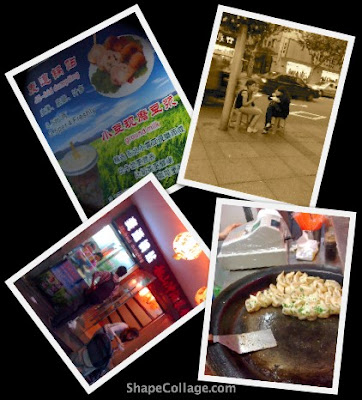
Ah, another breed of pork dumplings to enter the fray. These JZ fried dumplings, are what’s usually referred to as potstickers or 锅贴 guo tie. They’re also pan-fried, but unlike Yang’s Fried Dumplings, these potstickers are made of thin, smooth unleavened flour skins. The dumplings are served with a sprinkling of scallions, and it’s good to eat them just as they are, but if you so wish, I spy a bottle of vinegar at the counter. JZ is just a small booth-stall, so most patrons buy the dumplings to go. But if you need to satisfy your hunger pangs there and then, most patrons either finish them while standing at the pavement around the stall, walk a little further down or up the stretch and sit by curbsides or steps of buildings or if you’re lucky, catch a spot at the only two plastic stools, probably provided by JZ, near the edge of the road.
The JZ dumplings are sold in 4s, for RMB 3.5. If you need an accompanying drink, soybean milk is available at RMB 2.5 a cup.
This JZ that we chanced upon when we made our way from JIA to The Bund, possibly around 10-15 min walk away from JIA, is located at 599 Nanjing West Road (near Chengdu North road). If you can read Chinese, this website (http://www.dianping.com/search/keyword/1/10_%E9%BA%A6%E9%81%93%E9%94%85%E8%B4%B4) has a listing of the 8 other outlets of JZ’s.
As I Googled for the listings of Shanghai eateries, www.dianping.com kept coming up. On further digging, www.dianping.com, bills itself as “China’s largest online city guide for food, shopping and lifestyle” and seems like a rather credible and popular website. So if you’re comfortably literate in Chinese, this website could be an invaluable resource for your China travels research. It’s a listings website that covers major Chinese cities and provides listings of various categories – such as food, hotel, shopping etc, with accompanying user reviews. The website also has tie-ups with various businesses, which offer promotional coupons for customers to download in their handphone (presumably a Chinese mobile line) or print via the website. The website also has a free iPhone app version (http://itunes.apple.com/us/app/id351091731?mt=8#).
